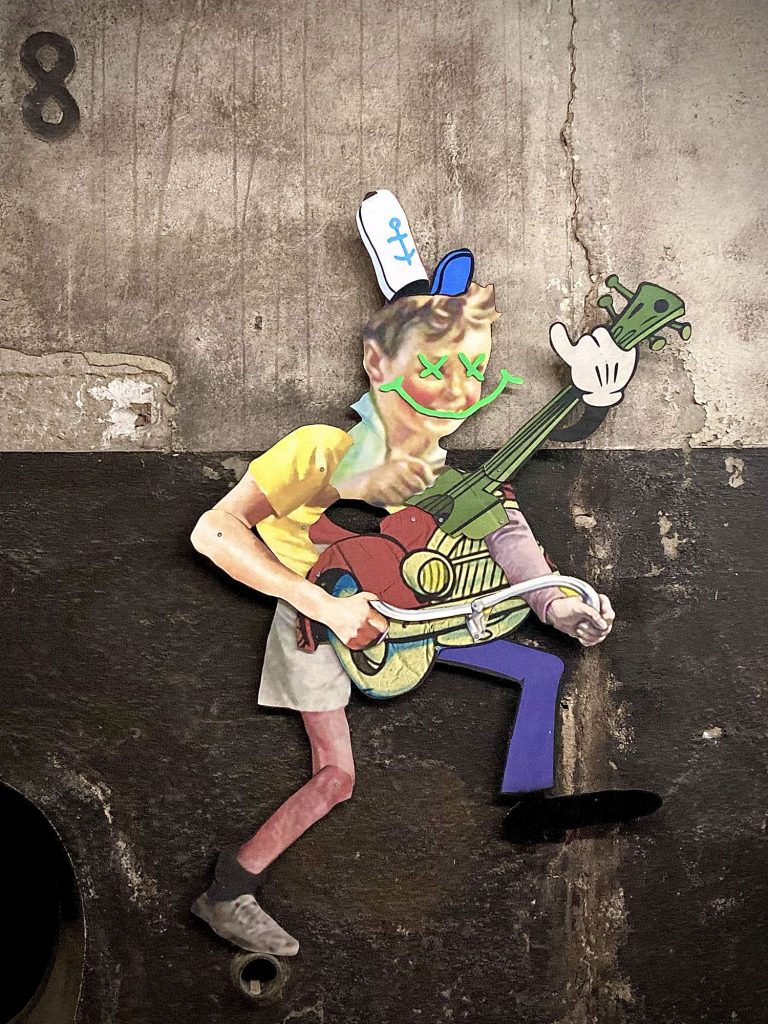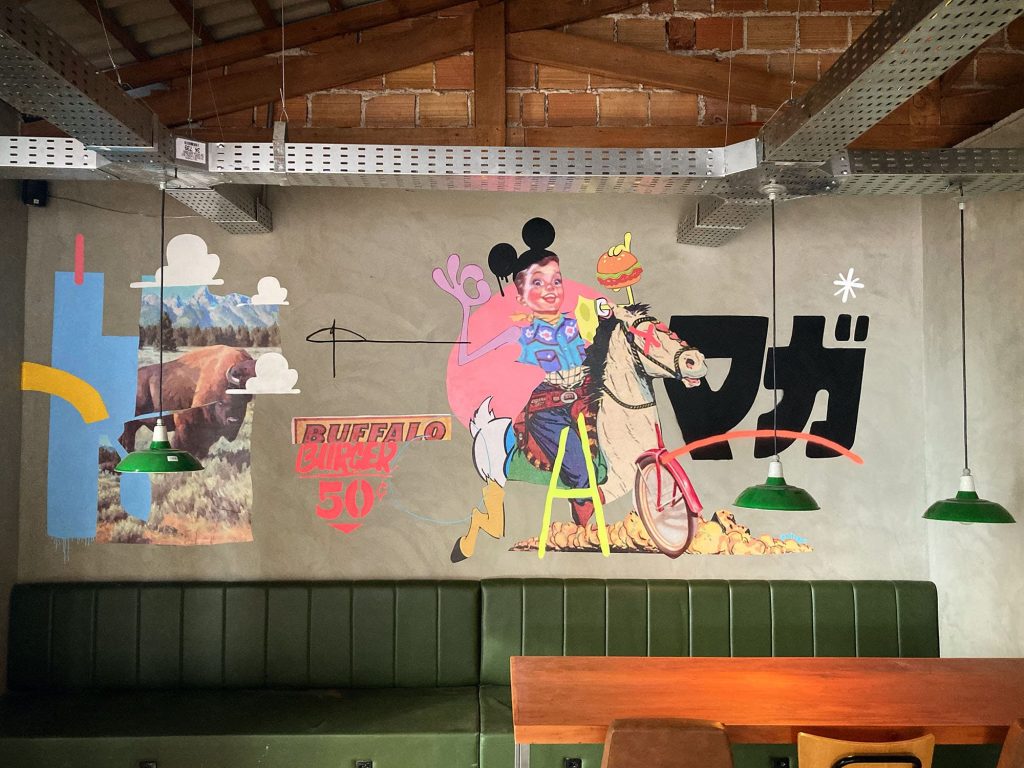TWS: What first sparked your interest in visual creation? How did your journey into art begin?
B –My interest in visual creation started way back in childhood. My mom worked at an ad agency in the late ’80s and early ’90s — back when everything was analog. She was in charge of planning and production, and I remember sitting next to the designers’ drawing boards, watching them put together graphic pieces. The materials they used were magical to me — paints, airbrushes… I was totally hooked.
Later on, after finishing school and before college, I started working as a junior art finisher at a friend of my mom’s agency in 1997. That was a turning point. I was suddenly surrounded by real artists — designers, a journalist, musicians. The creative process blended visual and audio, and I started learning how to draw inspiration from what I saw and heard. At that point, everything was already digital.
TWS –How did your upbringing and early environment shape your creative mindset and artistic path?
B –I come from a family connected to communication. My uncle (my mom’s older brother) was a radio soap opera actor in Rio and later hosted a radio show and a TV news program. Our family was always surrounded by music — both during get-togethers and in everyday life.
With that kind of background, it was hard to be a rebel — I had too much freedom, haha. Then I found skate culture in the ’90s — it was a whole universe of new stuff: music, videos, art, fashion… everything mixed together.



TWS –Were there any key people, experiences, or moments that marked a turning point in your path as an artist?
B –Yeah, two moments really hit me hard — like, made my knees weak.
The first was while I was studying Visual Arts. I was designing posters for theater groups and had a lot of creative freedom. I was always trying to break away from the obvious, mixing art and design, and starting to play with collage. Around that time, I joined a band — the guitarist was German and studying design at the same college. One day, he said, “I’m gonna show you something special,” and he introduced me to Wooster Collective, this blog about street art that was just getting started. Today’s big names were all there at the beginning. I remember thinking, this is what I want to do with my life.
When I was a kid, I was into comic books full of superheroes. Visiting Wooster every day gave me that same rush — but now the heroes were street artists.
The second moment was during a workshop with the artist Beto Shibata — who’s now a friend. I was starting to make my own collages and testing things out in public spaces. In that workshop, Beto introduced me to publications on — and this was the first time I heard the term — contemporary collage. I discovered artists that made me think again, this is it, this is what I want. It made me realize there was a real scene out there — and that I was part of something bigger.
TWS –Pop culture plays a big role in your visual universe—how does that connect to your personal history?
B –I think it has a lot to do with the generation I grew up in. It was the age of pop art, when we were all starting to discover and exchange ideas from around the world. That became my background — even before I really realized it.
Also, my mom’s younger brother moved to the U.S. in 1982 — and he still lives there. I remember he’d send us catalogs from Sam’s Club, comic books, VHS tapes with He-Man cartoons…
So, pop culture in my work is less about a planned aesthetic and more like a way to reconnect with my childhood.
TWS –How do you typically start a new piece—what sparks the process for you?
B –This is one of those answers that’s hard to give without sounding cliché. I’m always tuned in to the subtle stuff in life. I feel like I’m in a more poetic phase right now (we’ll get to that later, haha).
In general, everyday life is my biggest influence — a character I remember, a movement in an image, a story that comes out of a random conversation. That’s when things start clicking with images I’ve already collected — or ones I go looking for.


TWS –If your visual universe were a recipe, what ingredients would it include?
B –Haha, love this one!
A pinch of deconstruction, a splash of color, and a big dose of nostalgic memory. Boil it in poetry — and serve it hot!
TWS –What’s your relationship with materials like? Do you have preferred tools or do you experiment freely?
B –When I first started out, I worked in a very classic collage style: paper, scissors, a blade, and glue. Those are still my go-to tools, my comfort zone.
Over time, I started adding other materials and techniques — mainly paint and spray. Lately, I’ve been really into learning how to use oil pastels. Funny thing is, I always start off using a new material very cautiously — like, just testing it out to see if it fits the work.
But collage is still the main thread that ties everything together. Even with pieces that don’t include any collage, like stencils, the whole creation process starts with collage.
TWS –How do you navigate between analog and digital methods in your work?
B –I came into the scene during the digital design era — very different from the old-school drawing boards I saw at my mom’s agency. So I never wanted to take some kind of “digital vs. analog” stance or be purist about it.
What I really value is freedom — not being stuck to rules about what’s “legit” in collage.
I have a big collection of digitized images, which I started building when I began working with large formats. I’d scan my cutouts to resize them.
Even now, I do the digital part first — resizing and organizing — but the final piece is always analog. I love textures, layering, wrinkles.
I think that balance between analog and digital gives the work its character. And it opened the door for me to experiment more with urban art — where a lot of this creative process actually began.

TWS –In a world oversaturated with visual stimuli, how do you make sense of the images around you—and what guides your selection and use of found materials in your work?
B –Since we’re all swimming in this sea of visual stimuli, I try to “reorganize” the chaos and breathe new life into things that already existed — or still do — but now through my lens.
I dive into childhood memories from the ‘80s, almost like digging through a personal treasure chest for raw material. Family photos, cartoons, comic book characters, supermarket flyers… they all become layers in my collages.
TWS –How do cultural or geographic contexts shape the way your work is understood or received, especially with its strong pop culture references?
B –That’s definitely a challenge. Sometimes people see my work as humorous — which isn’t how I approach it at all.
I’ve got a version of my work that’s more geared toward the art market, and I show at fairs in Lisbon (where I live) and abroad — I was recently in a market in London.
In those spaces, the work takes on a whole different kind of life, almost like street art. The way people interpret it really varies.
What I’ve learned is that something that makes sense to me might not mean anything to someone else. My references are pretty specific, and that’s shown me how we all belong to little niches.
The pop culture in my work isn’t just a style choice — it’s part of my lived experience. So the work needs to find its people, rather than just trying to “fit in” anywhere.



TWS –How has working in public spaces influenced the way you think about audience, visibility, or impermanence?
B –I think the biggest shift was learning to let go of artistic ego.
When you put something on the street, it’s out there for everyone: a thousand people might not even notice it, a thousand might not like it, and a thousand might connect with it deeply.
That breaks you out of the comfort zone of the art world. Street art is just pure expression.
And the impermanence — for me, that’s the fuel behind the poetry of it all. A piece might last a day or just an hour, and that’s what makes it so special. Just like our own journey.
TWS –What questions or issues do you find yourself exploring through your practice right now?
B –The other day I saw an interview with Portuguese poet Matilde Campilho, and it got me thinking. Poetry, to me, is a way to write down the moments life gives you.
The poet is the one who catches those little everyday details and turns them into something meaningful. The kind of stuff people usually overlook — like a warm ray of sun on a cold morning. You know, those cheesy little things that actually make life richer.
TWS –Do you see your work as having a narrative, or is it more about atmosphere, memory, or emotion?
B –I like to think of it as these ideas coming together like little beings — born from forgotten memories — like walking into a dark room full of pieces and fragments that suddenly form something new.
Those “creatures” are always hanging around in my personal archive.
TWS –What excites or challenges you about the future of your work and where it might lead?
B –What excites me is experimenting — with new formats, new materials, new techniques. Even if it’s just in small steps, like I mentioned before.
Thinking about new projects is always a mix of challenge and thrill.
I’m not really worried about where it’ll take me. What I want is for the work to keep getting stronger and more consistent.


TWS –What’s something people often misunderstand about collage as a medium?
B –In the art world — especially in academic settings — we’re often taught that technique is almost as sacred as the act of creating itself. But to me, technique is just a tool.
Think about it: most people can write, but only some become writers — the kind who create touching, powerful bestsellers. It doesn’t really matter how they wrote it — on a typewriter, a computer, or by hand. What matters is the expression in those words.
I feel like art should be seen the same way. But we tend to put technique on the same pedestal as expression — or something close to that.
TWS –What’s your personal definition of collage?
B –To me, collage is more than just a technique — it’s a way of expressing yourself that makes creating art accessible to everyone. In the simple act of cutting, tearing, and gluing, there’s real creative freedom.
You don’t need any “divine gift” for drawing or painting. You just need to follow your gut, try stuff out, mess up, and figure it out as you go.
Learn more about Alexandre Makiolke / Bisner: Website / Instagram








